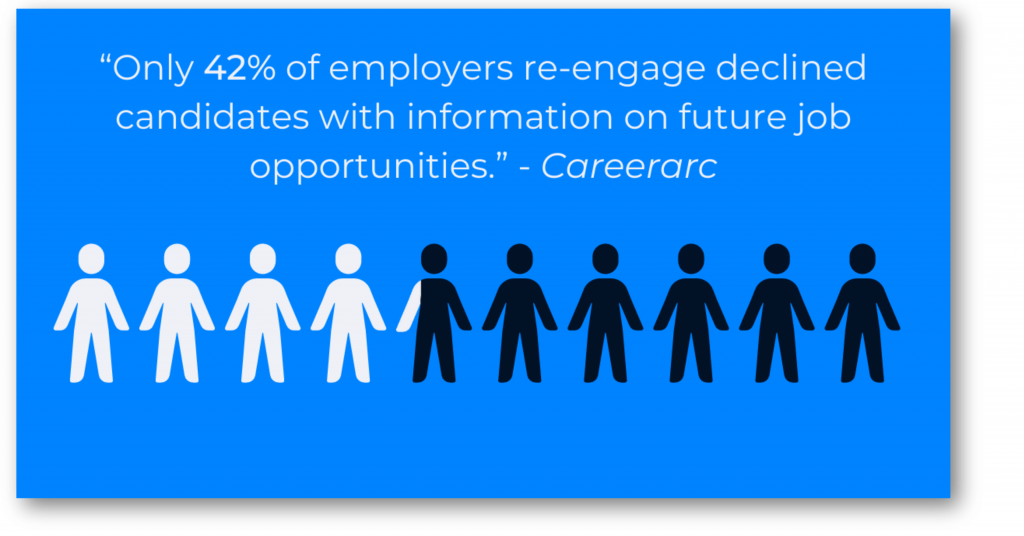Effectively building a candidate pool will help make your recruitment process easier
Recruiting alone doesn’t cut it in today’s competitive hiring environment. With so many viable options for employees, businesses — especially startups and scale-ups with less visibility — can no longer expect top talent to come to them, no matter how strong their brand is. Enter sourcing, the cousin of recruitment marketing. To hire effectively, businesses now need to activate passive potential by finding and engaging candidates who didn’t know they were candidates.
Candidate sourcing vs. recruiting
Despite a somewhat blurry definition line, sourcing and recruiting are different. Both sourcing and recruiting require a strong EVP, employer branding, and knowledge of the scale-up’s core value pillars and culture to reach the right people. However, recruitment marketing involves using materials to entice top talent and potential hires to enter the application process — funneling them from submitting a resume to accepting an offer letter. On the other hand, sourcing targets top talent who likely didn’t have your startup or Series A business on their radar as a potential employer. It opens up a significantly larger talent pool for your business: active talent looking for jobs as well as passive candidates.
If your SMB is struggling to fill roles and need employees now, consider implementing these sourcing strategies. They’re guaranteed to accelerate growth in your firm by bringing in long-lasting, passionate, scalable employees.
“Only 36 percent of the workforce is actively looking for a new opportunity at any given time, but an incredible 90 percent is willing to talk and learn more.”
How do you turn passive candidates into active hires? To start, use your current employees.
1- Leverage your current employees to source and attract talent
Whether recruited or sourced, potential hires want to know what it’s like to work for you. No one knows your company better than your current employees. Their knowledge and stories are invaluable when sourcing candidates and bringing in new team members — especially when a business needs to hire employees now. Potential hires need the following from your SMB:
- A clear EVP.
- Understanding of the startup’s culture and core values.
- A vision for how they, as an employee, can both give value to and gain value from the business.
Here’s how you can have current employees help fulfill those needs:
- Ensure employees have up-to-date profiles on their professional social media with active links to your site.
- Post employee features or videos of their experience at your company.
- Have employees write honest reviews on sites like Glassdoor.
”Existing employees are your best asset for building upon and promoting your culture amongst other employees and to future candidates.”
2. Create an Employee Insider program
Another fantastic way to leverage your current team is to create an employee referral program. Why are employee referrals worthwhile? Hiring rates for employee referrals are 4x higher than other sources, with about 45% of employees sourced from referrals staying on for longer than 4 years. Your team knows what you’re all about, and having them as advocates will bring in like-minded, hard-working individuals that already fit in with the company culture.
3. Re-engage past candidates who may be a better fit now
One of the biggest flops startups make when sourcing and hiring is not using past candidates. Why do extensive hiring research and work just to put it in the trash? If you’ve never reached out to past candidates, you’re not alone.
Now’s the time: Re-engage your past candidates. If you’re using proper KPIs for your hiring strategy, you’ll have information on — and will be able to reach out to — past candidates. They may have gone on to work somewhere else, weren’t qualified for the role at the time, or maybe had potential but would best fit a position that didn’t exist in your startup yet. As long as they’ve had a positive candidate experience and you’ve collected information, you can save a step and source candidates from past connections, expediting the time to hire.
Master the best techniques on how to create a positive recruitment process
4. Use technology to streamline sourcing and hiring efforts
A lot goes on in any startup, never mind adding candidate sourcing strategies. Luckily, there are numerous tech solutions that streamline and automate different aspects of day-to-day business. To start, use an ATS (applicant tracking system) like Recruitee to measure your candidate experience and collect data for future use, such as sourcing new hires from past candidates.
You can also bolster your tech stack for sourcing and hiring by using Hundred5 or HireVue to pre-screen candidates and ensure they have the right skillset (storing this information for potential future use). Finally, companies like Pivot + Edge are here to help. We simplify your sourcing and recruitment marketing to bring you only the best candidates across all sources, from job boards and university campuses to social media.
5. Build candidate personas and keep communications tight
It’s crucial to stay in touch and hold regular meetings with whoever is running point on your hiring strategy. To source the right people more effectively, ensure everyone is on the same page about what an excellent candidate looks like to your business. A great way to do this is through building targeted candidate personas.
Not entirely sure where to start? You’re not alone. Lots of startups and scaleups are so busy building their business that they seldom stop to think about anything beyond skills, education and experience. And while those are super important hiring metrics, here are some other powerful ones that compliment them such as: stage of career, internet habits, allowable weaknesses, experience geography (the cities/countries where they have experience in your industry), and the candidate’s immediate and long-term goals.
While some of these might sound obvious to you, having alignment on the answers you expect from a top-notch candidate will help you eliminate the ‘maybe’ pile of candidates you aren’t sure about. The ‘maybe pile is bad to have because they usually wait the longest for answers and if they fall through the cracks, then that relationship is probably gone. You could have someone who checked all the right boxes but wasn’t far enough ahead in their career for the level of responsibility in the role you’re offering; perhaps another candidate blew you away with their knowledge but have been using an entirely different set of tools and you don’t have the time to retrain them. These aren’t your ‘maybes’, they are your ‘not right now’s’, and you want to be able to call on them in the future if circumstances change.
You can also do this for roles that don’t exist in your company yet. Pre-sourcing for the future covers all your bases and puts you a step ahead as your company scales. For a more in-depth exploration of targeted personas and other top strategies for hiring at scale, check out our latest eBook here.
6. Align your candidate-facing messaging to your employer brand
You also want to perfect your messaging. Bland postings and ads don’t entice qualified talent, no matter the platform — especially if they’ve never heard of you before the first contact. There are three key components to writing better job postings that you can find here.
“[Sixty percent] of candidates have quit an application process because it took too long.”
7. Make it easier for candidates to apply to your startup
Finally, shorten up your hiring process. If you’ve sourced top talent, make the next steps snappy. Parse resumes, look for ways to expedite interviews and screenings, and get that job offer out there. A seamless process also ensures that your candidates, successful or not, will have had a good experience.
- A quick tip: Follow up with constructive feedback or a thank you note. Over half of job candidates don’t receive communication in the months following their application, but 80% of job seekers who did not receive an offer letter will reapply at the same business if they had a positive candidate experience. Building positive relationships is a simple yet effective way to source effectively for the future.
8. Bring in outside help to do the heavy lifting
If you’re feeling overwhelmed by these sourcing strategies, check out our webinar. It’s an informative SMB 101 that will help you scale up flawlessly. Get tips on recruitment marketing, branding, EVP development, and, of course, sourcing candidates. Short on time? Give us a shout, and Pivot + Edge can take care of it for you.









